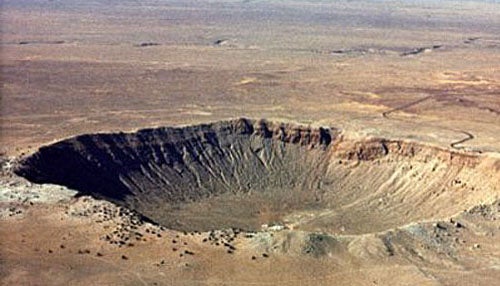Meteor Crater in northern Arizona was the first impact crater to be recognized on Earth. It was excavated about 50,000 years ago when a nickel-iron meteorite struck and blasted a hole three-quarters of a mile (1.2 kilometers) across. Past estimates by scientists generally held that the object struck at 9 to 12 miles (15 to 20 km) per second.
Now, however, two planetary scientists calculate that the crater came from a somewhat slower impact, about 7 to 8 miles (12 km) per second. In addition, say Jay Melosh of the University of Arizona and Gareth Collins of Imperial College, London, the impacting body broke up in the atmosphere and hit the ground in pieces. This, they say, explains why relatively little impact-melted rock has been discovered at the crater. Melosh and Collins also point to the large numbers of small, unmelted iron-meteorite fragments found near the crater.
Their computer model for the impact predicts a shock wave just ahead of the incoming body would start breaking it apart at an altitude of about 9 miles (14 km). By the time the meteorite had fallen to an altitude of 3 miles (5 km), they say, it was a pancake-shaped swarm roughly 700 feet (200 meters) across.
Writing in Nature (March 10, 2005), Melosh and Collins say, “The projectile would have been greatly slowed by the atmosphere and would have struck as a dispersed cluster of iron fragments.” When it struck, however, their calculations suggest one fragment probably contained about half the original object’s mass.
The amount of impact melt at Meteor Crater has been disputed by geologists. Some have explained the apparent lack as due to weathering during the 50,000 years since the impact. Others have suggested some impact melt was destroyed in the impact explosion. Asked how the discovery of more impact melt at the crater would affect their finding, Melosh told Astronomy, “That would point to a lesser amount of fragmentation” in the impacting body.
Meteor Crater lies between Flagstaff and Winslow, Arizona, about 6 miles (10 km) south of Interstate 40.










